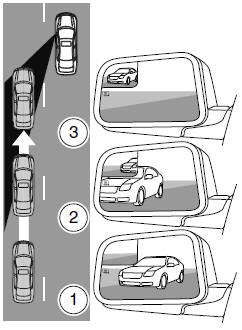Driving with blind spot mirrors


Before a lane change, check the main mirror first, then check the blind spot mirror. If no vehicles are present in the blind spot mirror and the traffic in the adjacent lane is at a safe distance, signal that you are going to change lanes. Glance over your shoulder to verify traffic is clear, and carefully change lanes.
When the approaching vehicle is at a distance, its image is small and near the inboard edge of the main mirror. As the vehicle approaches, the image becomes larger and begins to move outboard across the main mirror (1). As the vehicle approaches its image will transition from the main mirror and begin to appear in the blind spot mirror (2).
As the vehicle leaves the blind spot mirror it will transition to the driver’s peripheral field of view (3).
WARNING: Objects in the blind spot mirror are closer than they appear.
See also:
Rear seat head restraints
Your vehicle is equipped with rear seat outboard head restraints that
look differently than the front head restraints, but function similarly.
WARNING: To minimize the risk of neck injury in the ev ...
Paint chips
Your authorized dealer has touch-up paint to match your vehicle’s color.
Take your color code (printed on a sticker in the driver’s door jamb) to
your authorized dealer to ensure you get the corr ...
Cross traffic alert (CTA) system operation
The CTA system warns the driver of approaching vehicles when R
(Reverse) is selected and the vehicle is backing out of a front-in parking
spot. It sounds a series of tones and flashes the BLIS ind ...
